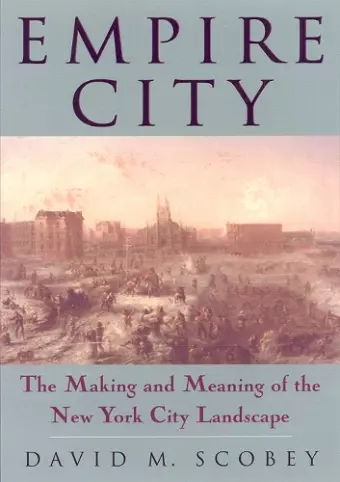Empire City
The Making And Meaning Of
Format:Paperback
Publisher:Temple University Press,U.S.
Published:30th Sep '03
Currently unavailable, and unfortunately no date known when it will be back

How did New York City come to represent the best and worst of urban life?
When the locals and the rest of the world say 'New York', they mean Manhattan, a crowded island of commercial districts and residential neighborhoods, skyscrapers and tenements, fabulously rich and abjectly poor cheek by jowl. This title tells the story of the dreams that inspired the changes in the landscape and the problems that eluded solution.For generations, New Yorkers have joked about "The City's" interminable tearing down and building up. The city that the whole world watches seems to be endlessly remaking itself. When the locals and the rest of the world say "New York," they mean Manhattan, a crowded island of commercial districts and residential neighborhoods, skyscrapers and tenements, fabulously rich and abjectly poor cheek by jowl. Of course, it was not always so; New York's metamorphosis from compact port to modern metropolis occurred during the mid-nineteenth century. Empire City tells the story of the dreams that inspired the changes in the landscape and the problems that eluded solution. Author David Scobey paints a remarkable panorama of New York's uneven development, a city-building process careening between obsessive calculation and speculative excess. Envisioning a new kind of national civilization, "bourgeois urbanists" attempted to make New York the nation's pre-eminent city. Ultimately, they created a mosaic of grand improvements, dynamic change, and environmental disorder. Empire City sets the stories of the city's most celebrated landmarks--Central Park, the Brooklyn Bridge, the downtown commercial center--within the context of this new ideal of landscape design and a politics of planned city building. Perhaps such an ambitious project for guiding growth, overcoming spatial problems, and uplifting the public was bound to fail; still, it grips the imagination. Author note: David M. Scobey is Associate Professor of Architecture and Director of the Arts of Citizenship Program at the University of Michigan.
"Exhaustively researched, beautifully written, and powerfully argued... Empire City will influence the theories and histories of urban geographers, historians, sociologists, and cultural theorists alike."-George Chauncey, University of Chicago, author of Gay New York "Lucidly written, deeply researched and thought through, Empire City zooms to the front rank of books about nineteenth century New York. Scobey examines the way real estate boosters, visionary reformers, business elites and Tammany politicos reshaped Gotham's cityscape, for good and ill. His analytical approach both illuminates a particular era, and provides a powerful general model for examining other times, other places."-Mike Wallace, co-author of Pulitzer-Prize winning Gotham: A History of New York "What made New York? In David Scobey's deft and deeply meditated account, it is not the blind forces of modernization nor the overarching will of an Haussman, but the complex interplay of interests, values and ideas-and above all the grandiose city-and nation-building aspirations of the 'bourgeois urbanists' of the 1860s and 70s. Scobey's New York is both a supremely self-conscious project-a 'mission civilatrice,' as he writes-and the battleground for the conflicting political, economic and social ambitions of an emergent world-city. This is a book for anyone who cares about cities-their future as well as their past."-James Traub, contributing writer for The New York Times Magazine and author of City On A Hill: Testing The America Dream At City College "Scobey has written a brilliant, evocative account of New York on the brink of economic and social chaos."-Journal of American History "Scobey's study is a significant contribution to literature in several fields... Perhaps most useful is Scobey's willingness to employ the lens of political economy to dissect the process of urbanization."-History: Review of New Books "It is best to treat [the book] not as a work of urban theory, but as a powerfully written (and very well illustrated) analysis of the specificities of class formation, class conflict and urban culture in the making of modern Manhattan."-Cultural Geographies "The most important achievement of David M. Scobey's study of New York city building and city planning in the 1860s and 1870s lies its combination of serious attention to political economy and culture."-The American Historical Review "If there were any concern that Scobey might not fire the imagination like a feature film, I can assure you that Scobey does his best not to disappoint. The book is lavishly illustrated with sumptuous prints of the New York landscape [which] add to the atmosphere created by Scobey's warm and relaxed writing style."-Environment and Planning
ISBN: 9781592132355
Dimensions: 254mm x 178mm x 23mm
Weight: unknown
352 pages